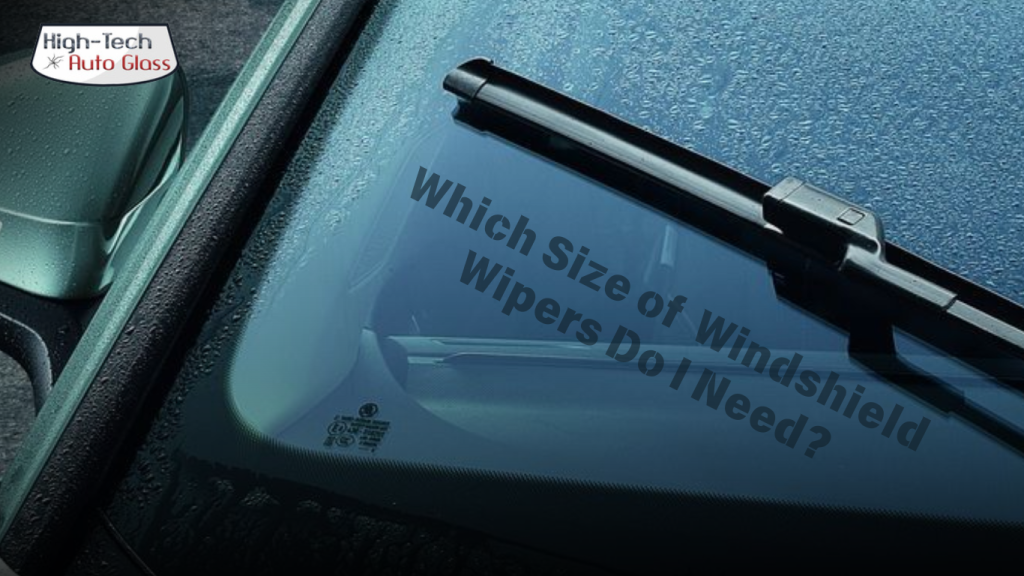What Size Windshield Wipers Do I Need?

Choosing the correct windshield wiper size is essential for maintaining clear visibility and driving safety. The right wiper blade size ensures that your wipers efficiently cover the entire windshield, providing a smooth and streak-free clean.
Selecting the proper wiper blades for your car also prevents unnecessary wear and tear, improving their longevity and performance.
Understanding your vehicle’s specific wiper blade sizes is Important for ensuring optimal performance, especially in challenging weather conditions like rain, snow, or ice. With the correct size, your wipers will work at their best, enhancing your driving experience.
Keeping both the exterior and interior of your windshield clean can significantly extend the life of your wipers. Accumulated dirt and oils on the inside can interfere with wiper function, reducing visibility. A proper cleaning routine can complement the wiper size you’ve selected.
How to Find Windshield Wiper Size
Check Your Car Manual or Use a Wiper Blade Size Chart
Start by referring to your vehicle’s manual for the recommended wiper blade sizes. It typically lists the correct sizes for both the driver and passenger sides, as well as the rear if applicable. If you don’t have the manual, you can also find a wiper blade size chart on many trusted automotive websites, like Rain-X’s Blade Size Finder for more precise measurements.
Measure Your Windshield Wipers to Ensure Correct Fit
If the manual or charts aren’t available, use a tape measure to check the size of your current windshield wipers. Measure the length of the wiper blade from one end to the other, ensuring that it matches the size needed for your car. Make sure to check both the driver’s and passenger’s sides, as they may differ in size.
Once you’ve determined the correct size for your windshield wipers, replacing them at the right time is crucial for maintaining clear visibility. If you’re unsure how to replace them, here’s a step-by-step guide to smooth wiper replacement process.
Use Online Tools to Determine the Right Size Wiper Blades for My Car
For extra convenience, use online tools to quickly determine the right size for your wipers. A webpage like Find My Wipers allows you to input your car’s make, model, and year to identify the correct wiper blade size. These tools make it simple to find the right wiper blades for your car without any guesswork.
What Size Wiper Blades for My Car?
Common Wiper Blade Sizes
Here is a table with common wiper blade sizes for both the driver and passenger sides, as well as considerations for the rear wiper:
Vehicle Type | Driver Side (Inches) | Passenger Side (Inches) | Rear Wiper (Inches) |
Compact Cars | 24-26 | 16-18 | 12-14 |
Sedans | 24-28 | 18-20 | 10-14 |
SUVs | 26-28 | 20-22 | 14-16 |
Trucks | 22-24 | 20-22 | 12-14 |
Minivans | 26-28 | 20-22 | 14-16 |
These sizes can vary based on the vehicle’s make and model, so it’s essential to consult your vehicle’s manual or use an online tool like FindMyWipers to ensure an accurate fit.
Special Considerations for the Rear Wiper
The rear wiper typically requires a different size than the front ones, and sometimes the size isn’t listed in the manual. For accurate measurements, check the existing wiper or use an online tool to find the rear wiper blade size that fits your vehicle. Rear wiper blades can be either smaller or the same size, depending on the vehicle model.
By following these steps, you can easily determine the correct wiper blade sizes for your car, including the rear wiper.
What Kind of Windshield Wipers Do I Need?
Wiper Blade Types
There are several types of wiper blades to choose from, and each serves a different purpose:
- Rubber Blades: Standard and budget-friendly, but wear out quicker. Ideal for mild climates.
- Silicone Blades: More durable and resistant to UV rays, making them great for warmer climates.
- Beam Blades: Designed for a smooth, streak-free wipe and excellent in high speeds or heavy rain.
- Winter Blades: These are designed for snowy or icy conditions, with a cover that prevents snow buildup.
Choosing Based on Weather or Driving Conditions
The type of windshield wipers you need depends on the climate and driving conditions. For snowy and icy areas, winter wiper blades are the best option, as they are specifically designed to handle harsher conditions. For rainy environments, beam blades or silicone blades work better due to their ability to handle higher speeds and more frequent wiping.
Best Wiper Blades for Snow and Ice
If you live in a region with frequent snow or ice, consider winter wiper blades. These blades are equipped with a protective rubber boot to prevent ice buildup and maintain flexibility in freezing temperatures. This feature ensures they continue to perform well even in the harshest conditions. You can also look into silicone blades for their durability and superior performance in cold weather. Protecting your windshield from flying rocks helps maintain wiper efficiency and glass integrity.
For more detailed guidance on choosing the right windshield wipers for snow and ice, visit this AutoZone guide.
Cold weather can impact the effectiveness of your windshield wipers. For instance, ice build-up can cause wipers to wear out quickly or even fail. It’s important to know how to properly defrost your windshield to avoid unnecessary damage to both the glass and your wipers.
Common Wiper Blade Fitting Types
Windshield wiper blades come with different types of fittings, and choosing the right one for your vehicle is crucial for proper installation. Here’s a breakdown of the most common wiper blade fitting types and their characteristics:
Fitting Type | Description | Compatibility Check |
Hook | Most common fitting; has a hook-shaped connection. | Ensure the wiper blade hook fits into the arm’s slot. |
Pin | Features a small pin that locks the blade onto the arm. | Verify the pin hole in the blade matches the pin on the arm. |
Bayonet | Uses a side locking mechanism with a narrow slot. | Confirm the bayonet slot lines up with the wiper arm. |
Side Lock | Blade is installed via a side latch that clicks into place. | Check the locking mechanism for a secure fit with the arm. |
Push Button | Blade clicks into place with a simple push-button mechanism. | Ensure the push-button locks the blade securely. |
To ensure compatibility, check your vehicle’s wiper arm type and choose the appropriate fitting. Many auto parts stores offer guides or online tools to confirm the correct fit.
What Happens if You Choose the Wrong Wiper Size?
Using the wrong wiper blade size can lead to several issues:
- Streaking: An improper fit can prevent the wiper from making full contact with the windshield, leading to streaks and reduced visibility.
- Excess Wear: A blade that’s too small or large may cause uneven wear, shortening its lifespan.
- Visibility Problems: Incorrect blade size can leave areas of the windshield uncleaned, compromising your view of the road, especially in heavy rain.
While windshield wipers play a big role in maintaining visibility during rain, foggy windows can also obstruct your view. Understanding how to defog your car windows is essential for ensuring that your wipers can do their job effectively when needed.
Conclusion
Choosing the right windshield wiper size is essential for maintaining clear visibility and ensuring your safety while driving. Whether you’re replacing the wipers for the driver, passenger, or rear side, it’s crucial to find the right fit for your vehicle. If you’re ever in need of windshield replacement, consider trusted experts like High-tech Autoglass in Phoenix. Their experienced team provides professional windshield replacement in Phoenix to ensure your vehicle stays in top condition, providing safety and clarity on every drive.
Frequently Asked Questions
How do I know what windshield wipers I need?
To determine the right wiper blades for your vehicle, refer to the car’s manual, use online tools, or measure your current blades. Vehicle make, model, and year will affect the size and type of wipers needed.
Can I use different sizes for each wiper?
Yes, the driver’s side wiper is usually longer than the passenger side, but some vehicles may use the same size for both.
Are all windshield wipers the same?
No, there are different types of wipers (e.g., rubber, silicone, beam, winter), each designed for specific weather conditions or vehicle requirements.
How often should I change my windshield wipers?
Wipers should be replaced every 6 to 12 months, depending on usage and weather conditions. If they start streaking or making noise, it’s time for a replacement.
What kind of wiper blades do I need for my car?
Choose the right wiper blade based on your climate. For rainy or snowy regions, silicone or winter blades may be better for durability, while rubber blades are more suitable for mild climates.
